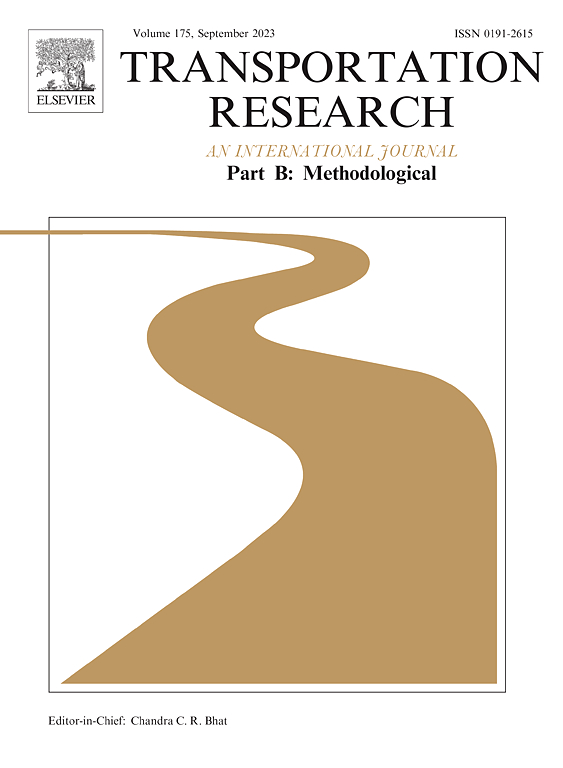铁路调车场综合驼峰排序、列车编组和分类轨道分配的迭代法
IF 5.8
1区 工程技术
Q1 ECONOMICS
引用次数: 0
摘要
在铁路调车场,将进站列车转化为编组合理的出站列车是一项复杂的任务,因为它涉及多个操作流程的决策。本研究探讨了铁路调车场中驼峰排序、列车编组和分类轨道分配的综合优化问题。研究考虑了几个关键的实际货场操作约束,包括列车编组约束、驼峰排序约束以及分级轨道最大数量和容量的限制。通过引入新的区块流表示法,采用扩展的单级策略和列车到轨策略的综合问题被表述为一个统一的 0-1 整数线性规划模型。该模型的目标是最小化所有轨道车的总停留时间与所有出站列车的制定偏差惩罚的加权和。然后,开发了一种两阶段迭代分解方法,以降低解决综合问题的复杂性。第一阶段的目标是使用分支-边界(B&B)算法探索所有可行的驼峰序列。每当第一阶段产生一个新的驼峰序列时,第二阶段就会应用包含分支加价算法(B&P)的算法,利用第一阶段发现的已知驼峰序列来解决综合列车编组和分类轨道分配问题。此外,两个阶段都设计了贪婪启发式和下限技术,以提高计算效率。基于一组真实实例进行了综合实验研究。结果表明,精确方法能提供最优解,而启发式方法则能在较短的计算时间内获得令人满意的解。此外,还对分类轨道的数量和不同偏差惩罚的影响进行了敏感性分析,以获得更多管理见解。本文章由计算机程序翻译,如有差异,请以英文原文为准。
An iterative method for integrated hump sequencing, train makeup, and classification track assignment in railway shunting yard
In a railway shunting yard, the transformation of inbound trains into properly composed outbound trains is a complex task because it involves decisions of multiple operations processes. This study addresses the integrated optimization of hump sequencing, train makeup, and classification track assignment problem in a railway shunting yard. Several key practical yard operation constraints are considered, including train formulation constraints, hump sequencing constraints, and limitations of the maximum number and capacity of classification tracks. By introducing a new representation of block flow, the integrated problem, which adopts the extended single-stage strategy and the train-to-track policy, is formulated as a unified 0-1 integer linear programming model. The objective of the proposed model is to minimize the weighted-sum of the total dwell time of all railcars and the formulation deviation penalties of all outbound trains. Then, an iterative two-phase decomposition approach is developed to reduce the complexity of solving the integrated problem. The first phase aims to explore all feasible humping sequences using a Branch-and-Bound (B&B) algorithm. Each time a new humping sequence is generated in the first phase, the second phase containing a Branch-and-Price (B&P) algorithm is applied to solve the integrated train makeup and classification track assignment problem with the known humping sequence found in the first phase. In addition, greedy heuristics and lower bounding techniques are designed in both phases to improve computational efficiency. Comprehensive experiments are investigated based on a set of real-life instances. The results show that exact approaches provide optimal solutions, whereas heuristic approaches yield satisfactory solutions within a shorter computation time. Moreover, sensitivity analyses on the number of classification tracks and the effects of different deviation penalties are also performed to gain more managerial insights.
求助全文
通过发布文献求助,成功后即可免费获取论文全文。
去求助
来源期刊
CiteScore
12.40
自引率
8.80%
发文量
143
审稿时长
14.1 weeks
期刊介绍:
Transportation Research: Part B publishes papers on all methodological aspects of the subject, particularly those that require mathematical analysis. The general theme of the journal is the development and solution of problems that are adequately motivated to deal with important aspects of the design and/or analysis of transportation systems. Areas covered include: traffic flow; design and analysis of transportation networks; control and scheduling; optimization; queuing theory; logistics; supply chains; development and application of statistical, econometric and mathematical models to address transportation problems; cost models; pricing and/or investment; traveler or shipper behavior; cost-benefit methodologies.

 求助内容:
求助内容: 应助结果提醒方式:
应助结果提醒方式:


